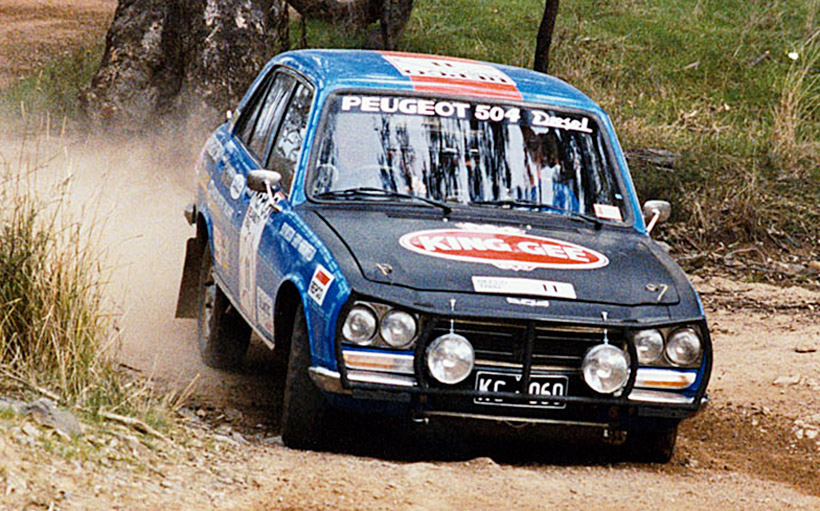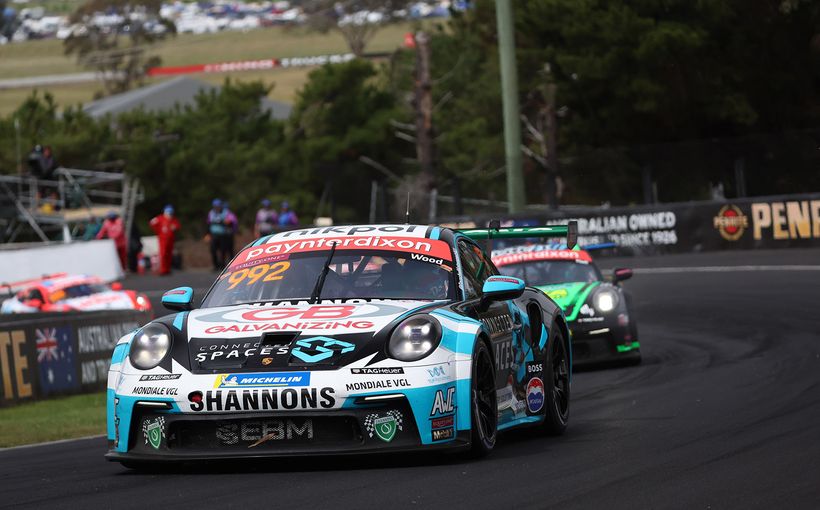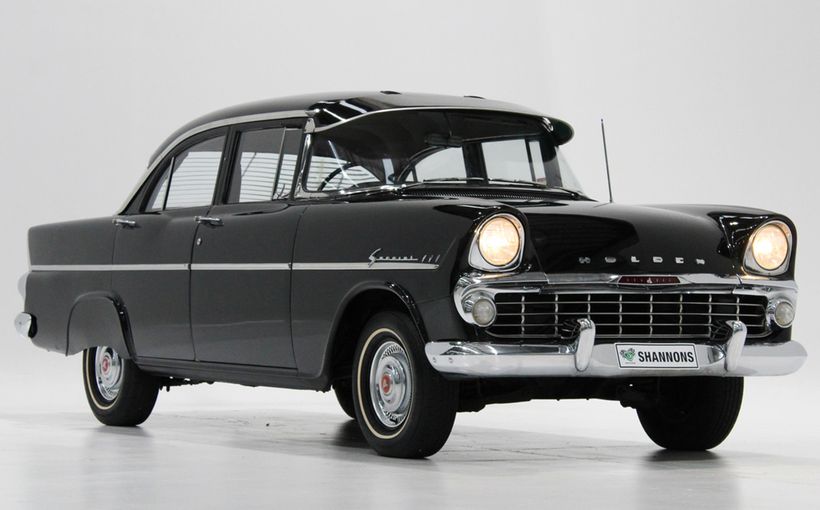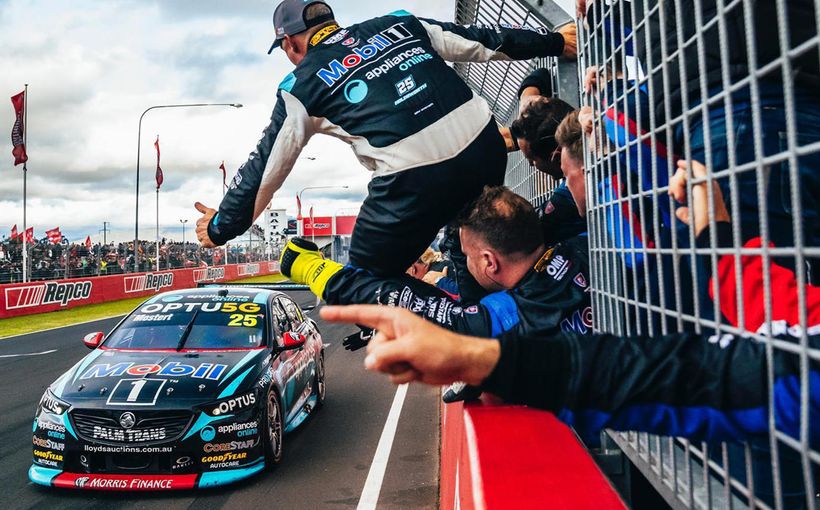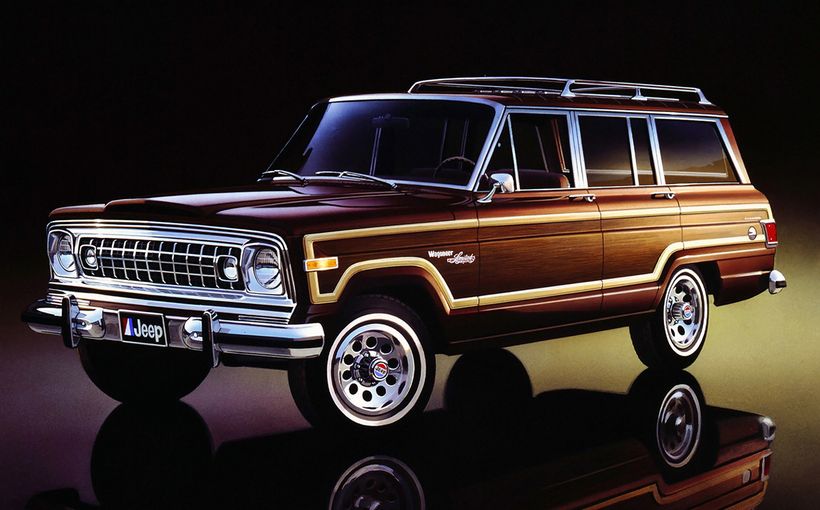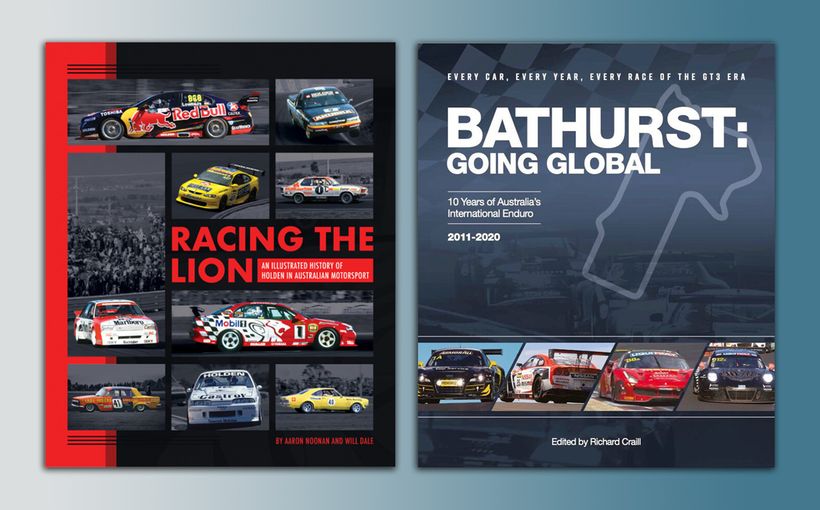Peugeot 504: Why the East African Safari champs snubbed the '79 Repco Trial

A remarkable performance by Bob Watson and Garry Harrowfield resulted in them being one of only 13 crews to complete the entire 20,000 km of the 1979 Repco Trial. Their diesel-powered Peugeot 504 was also the only ‘oil burner’ in the huge 167-car field. Image: www.bobwatsonrally.com.au
“That was a most disappointing decision, because those factory cars with 140 bhp fuel injected engines would have given the Commodores more than a run for their money,” Australian rally champion Bob Watson told Shannons Club, as he lamented Peugeot France’s late decision not to contest the 1979 Repco Round-Australia Trial with a multi-car 504 team.
“After we’d had a reasonable amount of success in the (1977) London to Sydney Marathon, Peugeot Australia got very excited about the Repco. They wanted to run three factory cars so they approached Peugeot in France and they were quite excited about it, too. They were going to supply three 504s built to full East African Safari specifications, with one to be driven by Timo Makinen and (co-driver) Jean Todt, another by myself and a third by Ross Dunkerton with our own co-drivers.
“So off I went to France with my mechanic Enzo Dozzi, where we saw the bare body shells and the special bits and pieces being assembled to build the cars. We also had a meeting with some Peugeot executives and Makinen and Todt were there. I folded out the maps and showed them what the Repco Trial was all about. I explained that the service breaks weren’t terribly generous and the rest breaks weren’t either, so it was going to be an ideal event for Peugeot.
“Makinen and Todt were looking at each other, scratching their heads and mumbling in French. Then we were called back into a meeting the next day and told that they were not going to proceed. Timo thought it looked a bit hard. He was getting near the end of his career and I don’t think he fancied taking on this horrible marathon event, so that cut the guts out of the whole thing.”

An African rally legend. Swedish aces Ove Andersson and Arne Hertz drove this 2.0 litre fuel injected 504 TI to victory in the 1975 East African Safari Rally - one of many African wins for the rugged French sedan. Note the name of the entrant on the rear passenger door. Kenya-based ‘Marshalls EA Ltd’ was the official Peugeot importer for East Africa and embraced the French brand’s rallying activities with great enthusiasm. Such involvement paid off handsomely, of course, with strong sales of 504s for many years. Image: www.pinterest.com
On reflection, had Peugeot’s world renowned competition department in Sochaux, France committed its formidable resources to winning the 1979 Repco Trial, a full-blown war between the multi-car Holden Commodore and Peugeot 504 teams would have been a riveting confrontation.
As it turned out, the well-funded and meticulously planned Holden attack masterminded by George Shepheard took control of the car-busting 20,000 km epic by two-thirds distance, as Peter Brock led home a stunning 1-2-3 team finish. For the last leg of the event down the east coast, the greatest challenge facing Shepheard was keeping a lid on inter-team rivalries, as his three crews jostled for the win.
However, had they been pushed – really pushed – the whole way by an equally well-prepared and professional rival like Peugeot France, with a heritage of success in notoriously harsh African rally events, the result could well have been different.
After East African Safari Rally dominance by the Peugeot 404 throughout the 1960s, the 504 proved an outstanding replacement, making its Safari debut in 1969 and soon building its legendary rally status in Africa.

Another shot of the 1975 East African Safari winner, showing the 504’s impressive fording abilities. The African rally cars were prepared by Peugeot’s competition department at Sochaux in France and then shipped to Marshalls in Kenya, which used its extensive local knowledge to co-ordinate the marque’s rallying activities on African soil with great success. Image: www.bringatrailer.com
Outright victories in the Ivory Coast’s incredibly tough Bandama Rally in 1971, 1974 and 1975 preceeded the 504’s first East African Safari victory in 1975, when Sweden’s Ove Anderson and Arne Hertz drove their works-prepared sedan to victory against faster but more fragile Lancia Stratos rivals. Hannu Mikkola and Jean Todt also drove a 504 sedan to victory in the 1975 Moroccan Rallye, which is on record as the longest World Rally Championship (WRC) event ever held with special stages of up to 800 km. The 504 won it again the following year.
In their search for more speed, Peugeot introduced the 504 Coupe which shared the 504’s rugged chassis platform enhanced by a Pininfarina-styled two door body and more powerful PRV 2.7 litre V6 engine. This variant claimed its first Bandama victory in 1976. It scored its second Bandama plus another East African Safari win for Peugeot two years later.
Numerous other long distance victories for the 504 included the gruelling ‘Grand Premio Panamericana’ or Rally Argentina in 1979, in which a pair of 504 sedans finished a resounding 1-2. This event included stages that climbed so high into the Andes Mountains that crews had to wear oxygen masks!
So what made the mighty Peugeot 504 such a brilliant rally car? The emphasis here is on ‘long distance’ rallies because the 504 was never designed to compete in shorter and faster WRC events. It was only in endurance events, over sadistically long distances and merciless terrain, where the tank-tough strength of the 504 sedan could really shine.

Peugeot’s handsome 504 Coupe proved to be just as rugged as its sedan stablemate and with more power from the larger 2.7 litre V6 engine. The Pininfarina-designed two-door enjoyed multiple victories and played an important role in building Peugeot’s legend status in Africa in the 1970s. Image: www.topgear.com
Even in factory-prepared rally trim, a Safari-grade 504 sedan with hand-built 2.0 litre fuel injected four cylinder engine only had about 140 bhp (some say up to 170 bhp) to motivate its relatively heavy but immensely strong unitary body-chassis unit.
With a kerb weight of around 1200 kgs, the 504 featured long travel independent suspension. A pair of MacPherson struts and a forged steel cross-member supported the front-end, matched to a beautifully simple coil-sprung independent rear with forged steel cross-member and big trailing arms. Four-wheel disc brakes provided great stopping power, while a rack and pinion provided sharp (if very low-geared) steering.
The end result was an African rally legend which combined an economical and under-stressed engine with huge ground clearance, supple ride quality, brilliant traction on all surfaces and a big load-carrying capacity.
“They were very strong in all the right places,” Bob Watson said. The 1970 Australian rally champion should know, as his association with the revered French sedan commenced in 1972 when he teamed with navigator Geoff Thomas to win the tough BP Rally in south-eastern Australia.
Watson would go on to compete in various 504s during the 1970s highlighted by the two biggest events in his driving career, which cemented the French sedan’s glowing reputation in Australia for strength and endurance.

No wonder Bob Watson is scratching his head, as he ponders the huge amount of work ahead in preparing four Peugeot 504s for the 1977 London to Sydney Rally in a matter of weeks. This shot was taken in the service garage at a Peugeot dealership in London, after the cars and their special rally parts had to be hastily shipped to the UK for assembly. The Aussie and UK mechanics did a great job building these cars in time for the start of the event. Image: www.bobwatsonrally.com.au
1977 Singapore Airlines London to Sydney Rally
The second running of the legendary London to Sydney Marathon was held, fittingly, a decade after the first. It was also timed to celebrate Singapore Airline’s 30 years of operation and stake its claim as the longest car rally in history.
Starting at London’s Covent Garden on August 13, it covered 30,000 kms across three continents in 30 days (plus shipping time) to reach the finish line at Sydney’s Opera House on September 28. The first 12 days spanned 11 countries from the UK through Europe, Turkey and the Middle East to India. The cars were shipped to Malaysia for the second leg to Singapore, before the survivors were shipped to Perth for the massive 13,000 km final leg across Australia.
Shipping problems on the way to Perth delayed the start of the Australian leg by two days. However, as the original finishing date in Sydney could not be moved, event organisers got the approval of teams to increase the average speeds and savagely cut the number of rest stops.
The nightmare result was 13,200 kilometres in just seven days and 16 hours – that’s more than 1,700 kms a day, or an average speed of 72 km/h for 184 hours! No surprise that only 38 of the original 69 starters finished the event. And that only 12 of them completed the entire course.

The Dunkerton/Watson/Bonhomme 504 TI approaching a control in the 1977 London to Sydney Rally. If these cars look pretty standard, that’s because they really were. Apart from basic rally preparations (sump guards, bull bars, lights, spares etc) these cars were as close to showroom stock as you could get.
However, no one knew such cruelty lay ahead when entries poured in from around the globe, which included factory teams from Mercedes Benz, Citroen, Fiat – and a four-car Peugeot 504 team with an all-Aussie driving line-up.
Three new 504 sedans and one 504 wagon were purchased from Peugeot in France, with the intention that all would be fully prepared by the company’s competition department in Sochaux. However, due to industrial unrest in France, the four cars and their special rally parts were hastily shipped to Peugeot’s major dealership in London where the Aussie team members and UK mechanics had to prepare the cars themselves – only weeks before the start.
The trio of 504 sedans had Bob Watson/Ross Dunkerton/Roger Bonhomme in one car, with Brian Hilton/Barry Lake and Bob Holden/Ian Munk teaming up in the other two. The lone 504 wagon, loaded with spares and tools, was primarily for rally driver and mechanic Gil Davis to provide service back-up along the route.
On reflection it’s amazing how close to standard these 504s were, given the merciless punishment they were about to be subjected to. The engine in each car was a standard issue 2.0 litre fuel-injected four cylinder unit producing about 110 bhp, mated to a four-speed gearbox and limited slip diff.

The top-placed Aussies attacking a typically rugged special stage in Greece during the 1977 London to Sydney. Note the large revolving light mounted on the roof, which combined with a police-style siren warned spectators in crowded villages that a rally car was approaching at high speed. Note also hubcaps designed to shield the wheel nuts from mud in case a wheel change was required. The hubcaps also served as a handy bowl to hold the wheel nuts during this process. The roof light and hubcaps were not needed for the final leg across Australia. Image: www.bobwatsonrally.com.au
Michelin rally tyres were fitted and suspension upgrades limited to installation of an even stronger rear suspension cross-member from the larger 604 model, plus heavy duty springs, gas-filled shocks and strut inserts. Stronger steering tie-rods were specified, along with ball-jointed steel rods that provided additional bracing between the body and the engine, gearbox and diff.
The battery was moved to the boot to improve weight distribution, nestled beside a huge foam-filled long distance fuel tank. There was also a bull bar and extra driving lights, alloy guards to protect the sump, gearbox and diff, plus heavy duty jacking points welded to the sills.
All floor carpet was removed along with the rear seat, to make room for three spare wheels, a spare radiator and tools. Seats were swapped for competition Recaros and the dashboard fitted with the obligatory Halda trip meter, stop watches and map lights.
The cars were prepared in time for the start, but unfortunately the Peugeot 504 wagon driven by Gil Davis crashed in eastern Turkey and had to be withdrawn. Even so, the other three team cars reached Australia well placed, with the Hilton/Lake and Dunkerton/Watson/Bonhomme 504s in the top 10 and well within striking distance of the leaders.
Unfortunately, the Bob Holden/Ian Munk 504 rolled on a sandy track and dropped out of contention. Hilton and Lake, who had been the Peugeot team’s pace-setters from the start, also struck trouble when a damaged thermostatic fan connection caused the engine to blow a head gasket which dropped them out of contention.

WA’s Ross Dunkerton is a study of concentration as he charges through the night during the incredibly tough Australian leg of the London to Sydney, during which cars had to maintain high average speeds and cover more than 1,700 kms a day in less than eight days. This car and crew climbed as high as third and were threatening the leading Mercedes 280Es until delayed by a gearbox gremlin. Image: www.bobwatsonrally.com.au
By the time the field had bashed and crashed its way to Adelaide, the Dunkerton/Watson/Bonhomme 504 was in third place and looking a major threat to the works Mercedes 280Es of rally leader Andrew Cowan and team-mate Tony Fowkes.
By the time the field reached Canberra, the Peugeot was only 40 minutes behind Cowan and closing, with more crucial stages ahead. It was all looking good until the 504 lost third gear, which had such an effect on the car’s performance that a time-consuming gearbox change was required.
“That’s what cost us a potential win and at least a top-three finish,” Watson lamented. “We lost third gear going over the Alps (Snowy Mountains) and by the time we reached Broken Hill (Menindee) we had to change it. Normally you could do that in about an hour or so, but because of all the extra parts restraining the engine and the big sump guard and all the rest of it, there was a lot of extra work involved. It took us about two and half hours, which dropped us way back.”
Even so, Peugeot No.54 finished fifth outright. Dunkerton, Watson and Bonhomme were also the highest-placed Australian crew, winning their class by more than 30 hours. However, the most sobering statistic was that they finished two hours and 15 minutes behind the winning Mercedes of Andrew Cowan. The gearbox change at Menindee cost them about the same amount of time…

One tough mother! The bruised and battered Dunkerton/Watson/Bonhomme 504 TI bares the battle scars of 30,000 kms of unrelenting abuse, as it arrives on the forecourt of Sydney’s Opera House at the end of the 1977 London to Sydney Rally. The all-Aussie crew’s fifth place and class win was a brilliant effort, given how close to standard their car was. Plus the fact they were only one of 12 crews to complete the entire course.
1979 Repco Round Australia Reliability Trial
Although Peugeot France decided against an all-out factory attack on the ’79 Repco, the company’s local head office under Renault Australia was still keen to back a quality local entry.
According to Watson, had Peugeot’s original three-car assault become a reality, the plan was to run a fourth car with a diesel engine to win a class for cars using alternative fuels. So the diesel initiative quickly became the primary focus.
Watson purchased the ex-Bob Holden London-Sydney 504, as he needed a car which had all the factory rally preparations already completed rather than trying to build up a new car from scratch. The 2.0 litre fuel-injected engine was removed and replaced with the 504’s optional 2.3 litre diesel four. It was the only diesel-powered entrant.

The Watson/Harrowfield Peugeot 504 diesel plunges into a creek crossing during the 1979 Repco Trial. The rugged French sedan required minimal servicing compared to some of its big dollar rivals, including the multi-car HDT Commodore team which at one stage changed their complete rear axle assemblies. Some rightfully questioned the Holden ‘reliability’ factor after the event.
“That diesel engine was stock standard and slow as a wet week,” Watson recalled. “And because the car was so slow, we couldn’t afford to carry a three-man crew, so we went with only a two-man crew which turned out to be bloody hard work. There was just myself and Garry Harrowfield, who was a Peugeot dealer in Ballarat well known to the company and a Victorian rally champion.
“We got some sponsorship from King Gee and Peugeot (Renault Australia) looked after us as best they could. They supplied Enzo Dozzi to build the car and a light aircraft to provide service and spares back-up throughout the event.”
In a show of physical and mental endurance which could be described as superhuman, Watson and Harrowfield finished 11th outright and first in class. They were also one of only 13 crews from the original 167 starters to complete the entire car-destroying course. The excellent book about the ’79 Repco Trial titled ‘An Old Dog For A Hard Road’ by Tom Floyd and Bill Tuckey, provides an excellent summation of their remarkable effort.
“These two lean, laconic, cheerful veterans, in a car that had already done the 1977 Marathon with a petrol engine, just kept rollin’ along, like Old Man River, despite a top speed of around 130km/h. They were as quick as many of the leaders on sections that suited the car and came back with an overall fuel consumption of a low of 13.3 litres/100 km (21 mpg) and a high of 7.0 litres/100 km (almost 40 mpg).
“All they did to the car was to replace two front struts because of minor oil leaks and change a rear shock absorber in Darwin. From Derby to Kununurra the starter motor failed when clogged by sand, but after being removed and cleaned it worked from then on. A stick jammed in the fan stripped the blades and they broke two windscreens, a brake pipe, the usual quota of lights, and changed dented rims more often than tyres, having far fewer punctures than almost any of the leading 30 cars. They didn’t even change the important diesel oil filter.

The 504 was a popular choice of car for the '79 Repco. This one shared by Wayne Herdy, Pat O’Kane and Brian Gramenz did well to finish 38th given the sadistic nature of the event. With more than 8,000 kms of special stages, competitors had to average nearly 1,400 kms a day for 14 days straight. That included 60 hours almost non-stop across The Nullarbor, 58 hours from Perth to Darwin and 62 hours from Darwin to Townsville.
“How the two-man crew, backed only by two mechanics and Mike Browning in a light aircraft, stayed with the action is one of the epics of endurance of the Repco. Drivers in the three-man crews were saying openly at the end that they just couldn’t understand how the double-acts kept going, yet they did.
“(Watson) told Bill Tuckey half way around that whoever had the turn to sleep in the left hand seat would tape on the dash the route instructions for the next 400 kms and pull his cap down over his eyes. Racing Car News magazine editor Max Stahl tells the story that at one rest point the two were so wiped out that the motel owner looked in through the door of their room and thought they were dead!”
Today, Watson’s memories of the crippling lack of sleep on the Repco remain vivid. To try to stay awake he lived on Beroccas, dissolving four of the fizzy vitamin tablets in a glass of water each time. For two weeks he was peeing bright red!

Peugeot Australia wasted no time in exploiting the exceptional performance of its 504 diesel in the ’79 Repco Trial, as seen by this full page newspaper advertisement at the time. Peugeot may not have established much of a connection with Mount Panorama over the years, but the French marque’s glowing reputation in long distance rallying is matched by few.
“We felt like we were nearly dead for most of the event,” Watson told Shannons Club. “The car was slow so we were losing time all the time. Between Adelaide and Perth the organisers allowed an extra 10 hours of late running time for that leg because it was very long, so we were literally in the car for 67 hours non-stop.
“When we got to Perth and Gloucester Park where the overnight stop was, Garry was so deeply asleep that I couldn’t possibly wake him up. And when I stepped out of the car my brother was there waiting and I literally could not make any words come out of my mouth. All I did was hug him, that’s all I could do. Then we only had about four or five hours’ sleep and we were off to Darwin. It was the hardest thing I’ve ever done.” And yet another glowing endorsement of the extraordinary qualities of the mighty Peugeot 504.
*Special thanks to Bob Watson for his valuable assistance in providing information and images for this story.

